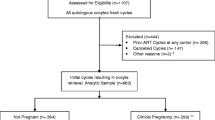Abstract
Objective
To compare the oocyte quality and intracytoplasmic sperm injection performance in women with isolated polycystic ovaries or polycystic ovarian syndrome.
Design
Retrospective study.
Setting
Fertility unit.
Population
Three study groups were identified: women with PCO-only morphology (50 cycles), PCOS (51 cycles) and age matched control group (104 cycles) with isolated male factor infertility necessitating ICSI.
Method
Controlled ovarian hyperstimulation and ICSI.
Main outcome measures
Response to gonadotropin stimulation, oocyte and embryo quality, clinical pregnancy rate and pregnancy outcome.
Results
Despite a significantly lower total gonadotropin dose, a significantly higher serum E2 level was attained in both the PCOS and the PCO-only groups compared to the control group. Although significantly more oocytes were retrieved in the PCOS and PCO-only groups, the number of 2-pronuclear embryos was similar to controls. No significant differences were noted in the maturity of the oocytes, oocyte dysmorphism, embryo quality, implantation and pregnancy rates among the three groups. However the clinical miscarriage rate was significantly lower in women with PCO-only morphology group (15.4 versus 31%, P < 0.05) than in the PCOS group.
Conclusion
Women with PCO-only appearance have shown to have similar characteristics to women with PCOS in terms of ovarian response to hMG stimulation, oocyte and embryo quality and pregnancy rates. However miscarriage rates were significantly lower in the PCO-only group than the PCOS group. Our findings suggest that factors unrelated to oocyte and embryo morphology present in PCOS patients may be instrumental in adverse reproductive outcomes in these women.
Similar content being viewed by others
References
Jacobs HS (1987) Polycystic ovaries and polycystic ovary syndrome. Gynecol Endocrinol 1:113–131
Franks S (1995) Polycystic ovary syndrome. N Eng J Med 333:853–861
Engmann L, Maconochie N, Sladkevicius P, Bekir J, Campbell S, Tan SL (1999) The outcome of in-vitro fertilization treatment in women with sonographic evidence of polycystic ovarian morphology. Hum Reprod 14:167–71
Ludwig M, Finas DF, al-Hasani S, Diedrich K, Ortmann O (1999) Oocyte quality and treatment outcome in intracytoplasmic sperm injection cycles of polycystic ovarian syndrome patients. Hum Reprod 14:354–358
Mulders AG, Laven JS, Imani B, Eijkemans MJ, Fauser BC (2003) IVF outcome in anovulatory infertility (WHO group 2)—including polycystic ovary syndrome—following previous unsuccessful ovulation induction. Reprod Biomed Online 7:50–58
Heijnen EM, Ejjkemans MJ, Hughes EG, Laven JS, Macklon NS, Fauser BC (2006) A meta-analysis of outcomes of conventional IVF in women with polycystic ovary syndrome. Hum Reprod 12:13–21
The Rotterdam ESHRE/ASRM-Sponsored PCOS consensus workshop group (2004) Revised 2003 consensus on diagnostic criteria and long-term health risks related to polycystic ovary syndrome (PCOS). Hum Reprod 19:41–47
Balen AH, Laven JS, Tan SL, Dewailly D (2003) Ultrasound assessment of the polycystic ovary: international consensus definitions. Hum Reprod Update 9:505–514
Muttukrishna S, McGarrigle H, Wakim R, Khadum I, Ranieri DM, Serhal P (2005) Antral follicle count, anti-mullerian hormone and inhibin B: predictors of ovarian response in assisted reproductive technology? BJOG 112:1384–1390
Van Steirteghem AC, Nagy Z, Joris H (1993) High fertilization and implantation rate after ICSI. Hum Reprod 8:1061–1066
Desai NN, Goldstein J, Rowland DY, Goldfarb JM (2000) Morphological evaluation of human embryos and derivation of an embryo quality scoring system specific for day 3 embryos: a preliminary study. Hum Reprod 15:2190–2196
Veeck LL, Bodine R, Clarke RN, Berrios R, Libraro J, Moschini RM, Zaninovic N, Rosenwaks Z (2004) High pregnancy rates can be achieved after freezing and thawing human blastocysts. Fertil Steril 82:1418–1427
Esinler I, Bayar U, Bozdag G, Yarali H (2005) Outcome of intracytoplasmic sperm injection in patients with polycystic ovary syndrome or isolated polycystic ovaries. Fertil Steril 84:932–937
Ebner T (2006) Is oocyte morphology prognostic of embryo developmental potential after ICSI? Reprod BioMed Online 12:507–512
Kahraman S, Yakin K, Dönmez E et al. (2000) Relationship between granular cytoplasm of oocytes and pregnancy outcome following intracytoplasmic sperm injection. Hum Reprod 15:2390–2393
Ebner T, Sommergruber M, Moser M, Sheb O, Schreier-Lechner E, Tews G (2006) Basal level of anti-Müllerian hormone is associated with oocyte quality in stimulated cycles. Hum Reprod 21:2022–2026
Otsuki J, Okada A, Morimoto K et al (2004) The relationship between pregnancy outcome and smooth endoplasmic reticulum clusters in MII human oocytes. Hum Reprod 19:1591–1597
Hardy K, Robinson FM, Paraschos T, Wicks R, Franks S, Winston RM (1995) Normal development and metabolic activity of preimplantation embryos in vitro from patients with polycystic ovaries. Hum Reprod 10:2125–2135
Norman RJ, Davies MJ, Lord J, Moran LJ (2002) The role of lifestyle modification in polycystic ovary syndrome. Trends Endocrinol Metab 13:251–257
Regan L, Owen EJ, Jacobs HS (1990) Hypersecretion of luteinising hormone, infertility, and miscarriage. Lancet 336:1141–1144
Balen AH, Tan SL, MacDougall J, Jacobs S (1993) Miscarraige rates following in vitro fertilization are increased in women with polycystic ovaries and reduced by pituitary desinsitisation with buserelin. Hum Reprod 8:959–964
Homburg R, Lewy T, Berkovitz D et al (1993) Gonadotropin releasing harmone antagonist reduces the miscarriage rate for pregnancy achieved in women with polycystic ovarian syndrome. Fertil Steril 59:527–531
Rai R, Backos M, Rushworth F, Regan L (2000) Polycystic ovaries and recurrent miscarriage—a reappraisal. Hum Reprod 15:612–615
Franks S, Roberts R, Hardy K (2003) Gonadotrophin regimens and oocyte quality in women with polycystic ovaries. Reprod Biomed Online 6:181–184
Mikkelsen AL, Lindenberg S (2001) Morphology of in-vitro matured oocytes: impact on fertility potential and embryo quality. Hum Reprod 16:1714–1718
Author information
Authors and Affiliations
Corresponding author
Rights and permissions
About this article
Cite this article
Sahu, B., Ozturk, O., Ranierri, M. et al. Comparison of oocyte quality and intracytoplasmic sperm injection outcome in women with isolated polycystic ovaries or polycystic ovarian syndrome. Arch Gynecol Obstet 277, 239–244 (2008). https://doi.org/10.1007/s00404-007-0462-x
Received:
Accepted:
Published:
Issue Date:
DOI: https://doi.org/10.1007/s00404-007-0462-x




